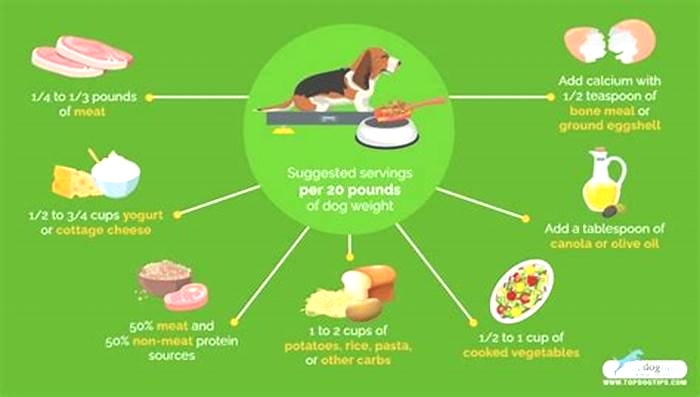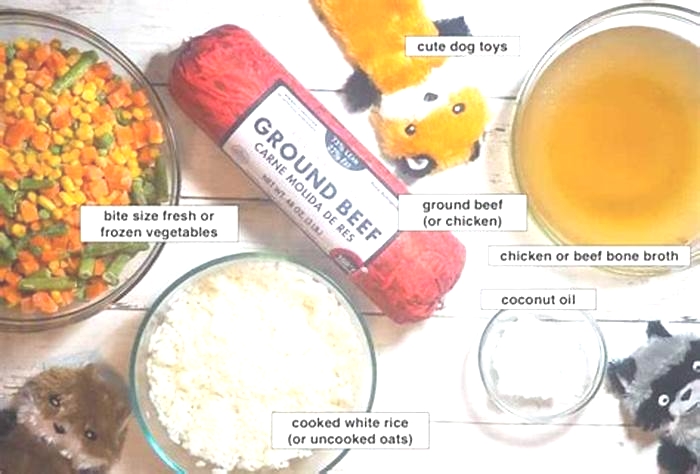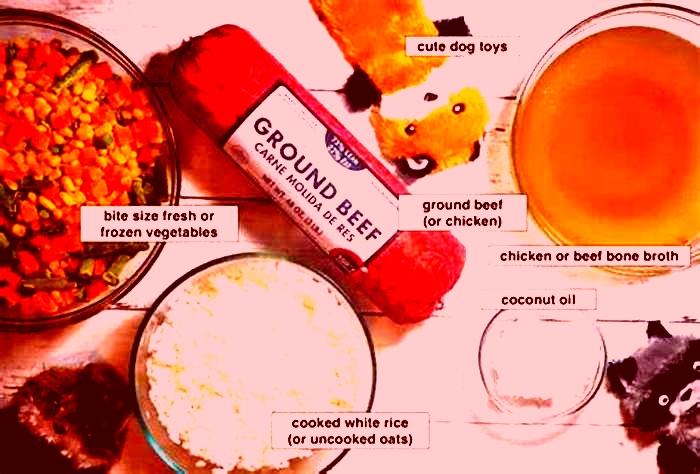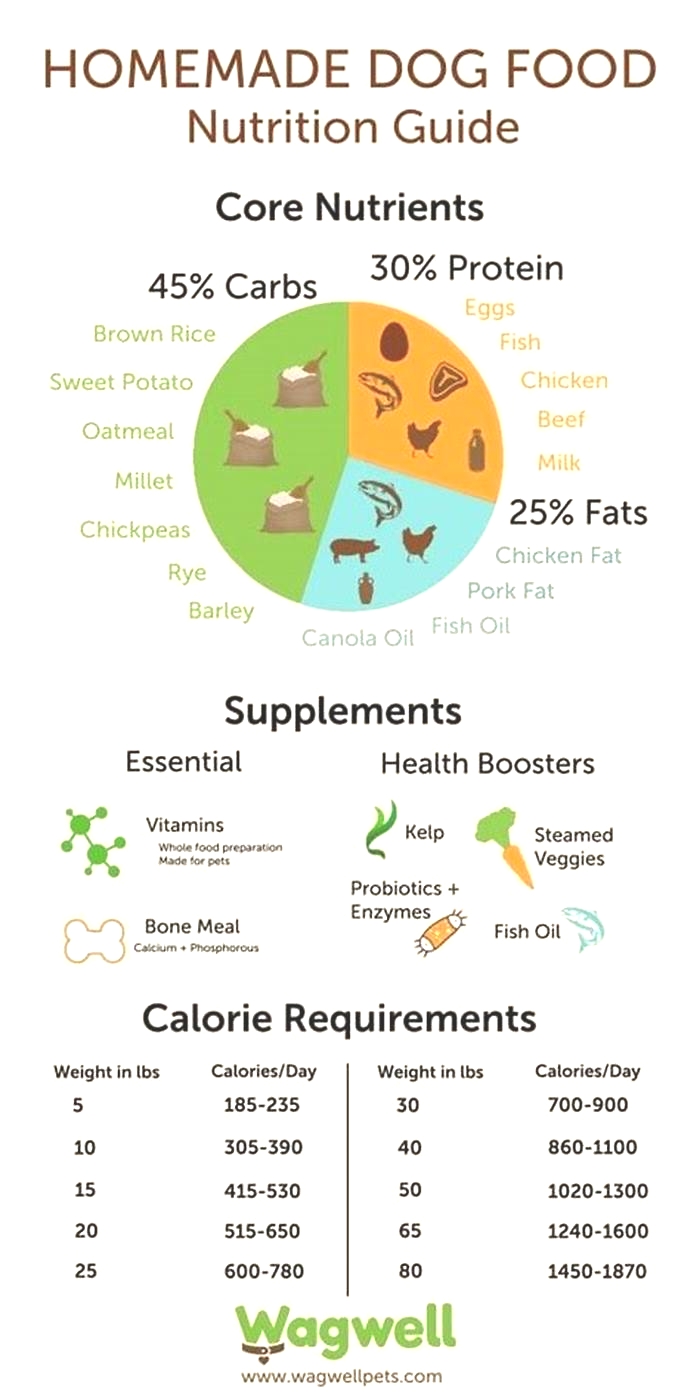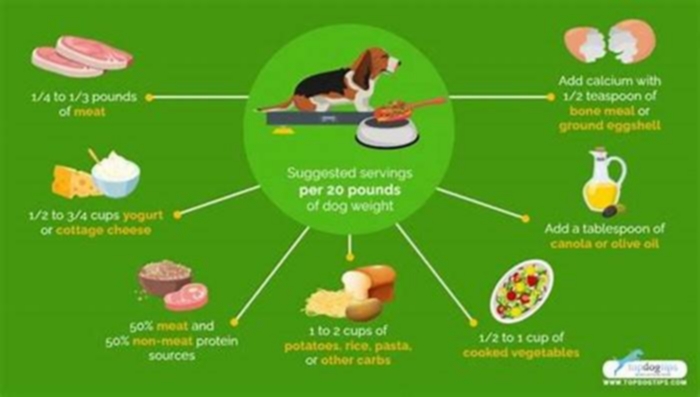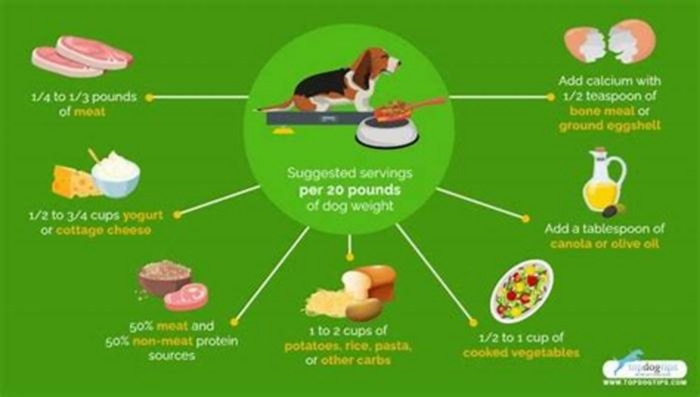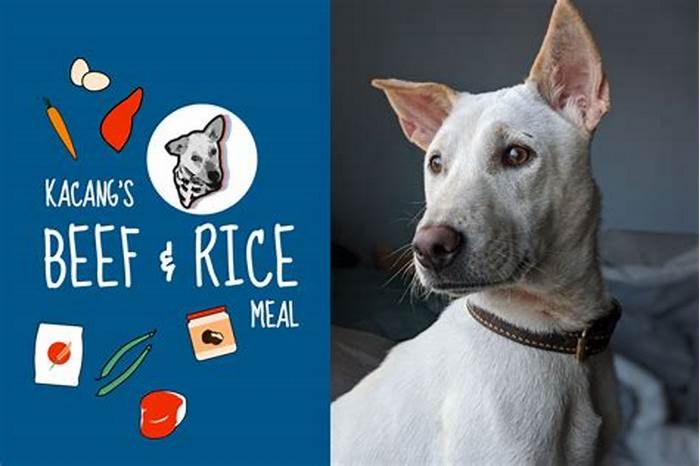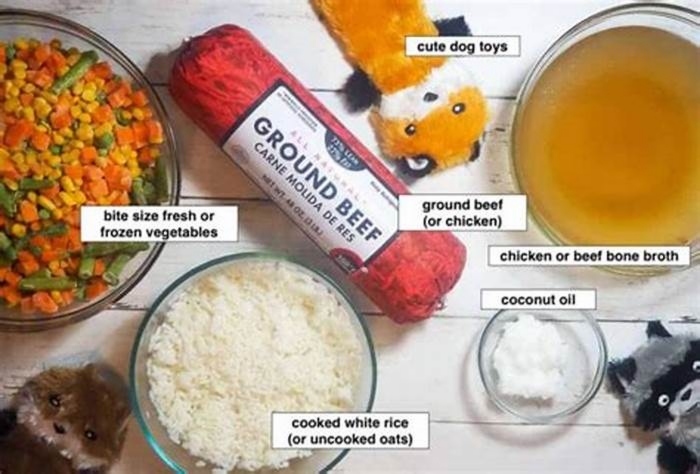homemade dog food ratio
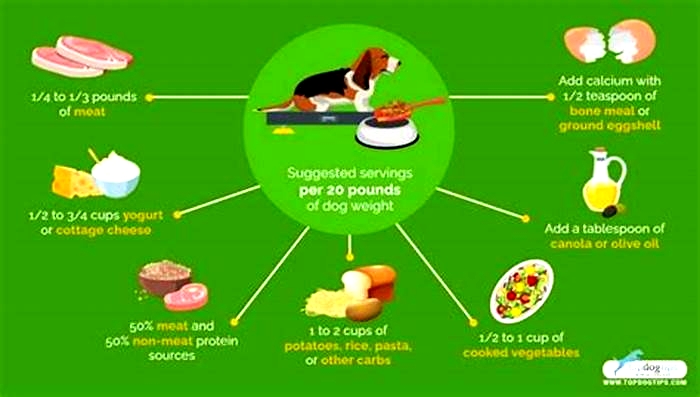
Ratio of Meat to Vegetables & Grain for Homemade Dog Food
Experts agree that protein, usually in the form of meat, should equal or exceed vegetables in a dog's diet -- they just don't agree on how far this should go. They also appear to disagree on the definition of vegetables; some include grains as vegetables and some separate the two.
Meat
Dogs are basically carnivores that have become omnivores through living with people. They can eat most of the things we eat, but they need more protein than we do. People can do well on a vegetarian diet and dogs can survive, but not thrive, on one. Experts recommend that anything from 1/3 to 3/4 of a dog's diet be protein, in the form of meat or non-meat protein, such as eggs, cottage cheese or cooked dried beans. Poultry (chicken, turkey, duck) and beef are the most common meats to feed dogs, but they'll also eat things that most people don't care for, from rabbit to possum. Organ meats, such as liver, heart, gizzards and tripe, are also acceptable and very good for dogs in moderation. Here's a good chance to use up that freezer-burned roast or the venison your hunter friend gave you that you don't really fancy.
Vegetables
Green and yellow vegetables and root crops other than white potatoes can make up anything from 1/3 to 1/4 of a dog's diet. These are best cooked to make them more digestible. A dog's digestive tract is shorter than a human's, so they have less time to extract nutrients from raw vegetation -- salads have no place on their menu. Pumpkin is a superfood for dogs, and while dogs aren't usually big fans of leafy greens, you can sneak these into a stew and they'll eat them along with the rest. You can also include some fruit -- offer apple slices (no seeds) as a treat. Vegetables supply vitamins, minerals and fiber.
Grains
Grains can make up 1/3 to 1/4 of a dog's diet, depending on his activity level and his need for quick energy, which is what carbohydrates supply. Whole grains, including rolled oats, barley and more exotic types such as quinoa, are good as long as they're cooked thoroughly, but one of the best and most readily available grains is rice. Brown rice is best for everyday meals, since it supplies some B vitamins and a bit of fiber from the seed coat, but white rice cooked in chicken broth makes a bland diet for a sick dog or one who's just off his feed.
The Other Ratio
There's another important ratio to be considered in a dog's diet -- that of calcium to phosphorus. Ideally, this should be 1:1. If this ratio gets too far out of whack, your dog's body will take calcium from his bones to make up what's not in his diet, and this can lead to osteoporosis and other skeletal problems. Meat, especially organ meat, is high in phosphorus and low in calcium. If you feed a home-cooked diet but don't give your dogs raw bones to gnaw, you need to add a calcium supplement in the form of powdered eggshell or calcium carbonate (indigestion tablets). Your vet can advise you best on how much your dog should get, but 900mg per pound of food is generally considered adequate.
Homemade Dog Food Calculator
Providing fresh, homemade food for your dog is one of the best things that you can do for his health and well-being and you can do it using a homemade dog food calculator.
Whenever pet owners broach this subject with me, they often bring up how difficult a homemade dog food calculator can be.
Yes, creating recipes to meet your dog's nutritional needs can be a challenge. But, thishomemade dog food recipe calculator will make the process a little easier.
Many pet owners believe that they can feed their dog the same quantity of homemade food as recommended by their old commercial kibble brand.
That could not be more wrong!
Homemade dog food is more nutritionally dense than most commercial foods. This means that your dog won't need as much to get the same nutritional benefits.
I've also heard pet owners share misinformation about watching a dog's weight and adjusting the serving sizes accordingly. That's why it is important to use a homemade dog food calculator.
If the dog is gaining weight, lessen the serving size. If he's losing weight, increase the serving size.
Why Do We Calculate Dog Food?
 The consequences of feeding your dog too much food are obvious.He'll become obese, which could lead to a slew of other health conditions like diabetes, joint problems, certain types of cancer, and heart and respiratory issues.
The consequences of feeding your dog too much food are obvious.He'll become obese, which could lead to a slew of other health conditions like diabetes, joint problems, certain types of cancer, and heart and respiratory issues.
Did you know that feeding your dog too much food can also lead to nutrient toxicity? In the case of nutrition, too much of a good thing could be very bad! For example, Vitamin A toxicity can cause bone spurs, lethargy, constipation, stiffness, and limping.
On the other hand, if you're not feeding your dog enough, he couldbecome nutrient deficientquite quickly. If you don't realize your dog isn't getting the proper nutrients, he may become weak and his organs could start to fail. Ultimately, nutrient deficiency can lead to death if it's not corrected.
In short, it's crucial that you discuss a switch in your dog's nutrition with your veterinarian. It's also important to use this homemade dog food recipe calculator as a guideline for figuring out how much food to feed Fido at each serving.

Calculating Homemade Dog Food Recipe

The first thing you'll need to do when following a homemade dog food recipe calculator is to figure out your pet'sDaily Energy Requirements (DER). This is the amount of energy (also called calories) that your dog's body burns in a typical day.
Before you can find the DER, you'll need to find Fido's Resting Energy Requirement (RER).RER is the energy that your pooch needs to perform essential bodily functions like heart functions, brain functions, digestion, and respiration.
To find your dog's RER, you'll need to multiply his body weight in kilograms raised to the 3/4 power by 70. In equation form this looks like this:
70(body weight in kg. ^.75)
Let's take a look at an example. If your dog weighs 53 pounds, that converts to 24 kg. Now, raise 24 to the .75 power and you get 11.2 (rounded to the nearest tenth). The last step is multiple 70 x 11.2, which equals 784. A 53-pound dog's RER is 784.
Once you figure out the RER, you can move on to the DER. This gets a little trickier. To find the DER, you'll need to multiple the RER by a certain factor that meets Fido's description.
According to The Ohio State University Veterinary Medical Center, these are the factors that you can choose from:
| Neutered adult | =1.6 x RER |
| Intact adult | =1.8 x RER |
| Inactive/obese prone | =1.2-1.4 x RER |
| Weight loss | =1.0 x RER for ideal weight |
| Weight gain | =1.2-1.8 x RER for ideal weight |
| Active, working dogs | =2.0-5.0 x RER |
| Puppy 0-4 months | =3.0 x RER |
| Puppy 4 months to adult | = 2.0 x RER |
Summary of Homemade Dog Food Calculator
Remember, these are just estimates. They can vary by as much as 50%, so you have to understand that these numbers are just a general starting point. The best thing that you can do is discuss your homemade dog food diet with your veterinarian or a canine nutritionist who can help you understand your dog's caloric needs better.
READ NEXT: How Seasons Affect Your Dog's Dietary Needs
Homemade Dog Food Recipes: Choosing Balanced Ingredients
Are you considering switching your dog to a homemade diet? A good place to begin is by discussing it with your veterinarian and/or a veterinary nutritionist. You may think that sounds unnecessary when there are so many recipes for homecooked dog meals available on the internet. However, the experts say that many of those recipes were not reviewed by veterinary nutritionists to make sure they provide a nutritional, well-balanced diet for your dog. This is why some owners prefer to feed pre-made fresh food.
The American College of Veterinary Nutrition (ACVN) warns that your dogs unique nutritional requirements will depend on the age, size, health, and breed. Also, there are dogs for whom a homemade diet may not be appropriate or might even be damaging. We generally dont recommend homemade diets for a dog less than one-year-old. If young dogs dont receive the appropriate amount of calcium and phosphorus, significant bone abnormalities may result, says Dr. Jerry Klein, AKC chief veterinarian. Pregnant and lactating dogs also have unique dietary requirements that may not be addressed by a recipe found on the internet.


The ABCs of a Balanced Dog Food Diet
Understanding the basics of what makes a homecooked diet balanced for your dog will help when you discuss the options with an expert. Here are important ingredients for the canine diet.
Protein: According to the ACVN, dogs must have protein in their diets that contain 10 specific essential amino acids their bodies cant produce. This is necessary for the creation of glucose, which transforms into energy. Sources of protein include chicken and turkey, after removing bones, fat, and skin; beef and lamb; pork in limited amounts; salmon and some other fish such as whitefish, herring, walleye, flounder, and Arctic char.
Fats and fatty acids: The most concentrated sources of fats in a dogs diet come from animal fats and plant seed oils. A healthy diet supplies the fatty acids the dogs body doesnt manufacture. Fatty acids support the function and structure of cells, keep skin and coat healthy, and enhance the taste of the food. Sources of fatty acids include plant-based oils, including corn, soybean, canola, and flaxseed oil, as well as fish oil.
Carbohydrates: Dogs get some of their energy from carbohydrates, which include sugars, starches, and dietary fibers. Sources includerice, pasta, oatmeal, and quinoa.
Fiber: Dogs need fiber in their diet to keep their gastrointestinal (GI) system functioning and to help them from becoming overweight. Good sources of fiber for dogs include carrots, pumpkin, apples, dark leafy greens, brown rice, and flaxseed.
Vitamins: Vitamins are required for growth and maintenance. Vitamin deficiencies can cause a variety of health problems; however, they can also be dangerous in large quantities.
Vitamins dogs require include A (carrots, pumpkin), B vitamins (liver, green vegetables, whole grains), C (fruits and vegetables, organ meat), D (liver, fish, beef), E (leafy green vegetables, liver, bran, plant oils), K (fish, leafy green vegetables, fish), and choline (liver, fish, meats, egg yolks).
Minerals: There are 12 essential minerals for dogs:
- Calcium (tofu, green beans, broccoli, and cauliflower) and phosphorus (meat, eggs) for strong bones and teeth.
- Magnesium, potassium, sodium, and chloride (fruits, vegetables, whole grains) for nerve impulse transmission, muscle contraction, and cell signaling.
- Sulfur (meat, fish, molasses) for healthy skin, coat, and nails.
- Iron (red meats, poultry) for supporting red blood cells and the immune system.
- Iodine (dairy, kelp, seafood) for a healthy thyroid.
- Zinc (eggs, lamb, liver, brewers yeast) for the immune system, healthy skin, and coat.
- Selenium (meat, vegetables, seafood, brown rice) to boost the immune system.
- Copper (whole grains, seeds, and seafood) for healthy bone growth.
Water: We sometimes overlook this important ingredient of a healthy dogs diet, but there really is no dog food that contains enough water for your dog. Keep clean, fresh water out always.

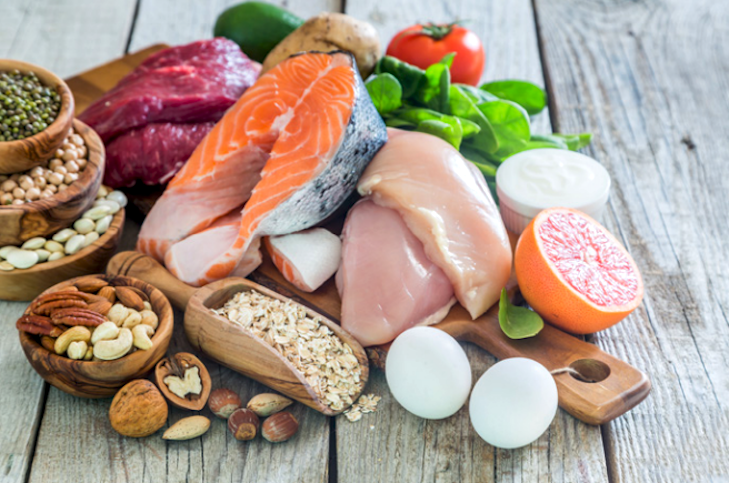
Making the Transition
Consult a veterinarian: If youve decided to transition your dog to a homemade diet, your first step should be to consult a veterinarian or veterinary nutritionist. Those experts will consider your dogs age, size, and health history and help you identify a high-quality recipe that is tailored to meet your dogs specific nutritional needs.
Buying ingredients: When you buy ingredients for your dogs homemade meals, you need to pay as much attention to the source, expiration dates, and labels as you do when you buy food for yourself.
Making the switch gradually: Whenever you change your dogs food, whether to a homemade diet or a new commercial food, a gradual switch is best to avoid upsetting your dogs GI system. For at least five-to-seven days, gradually mix in more and more of the new food with the old food, as you allow your dog to adjust to the change.
Follow the recipe: Be sure to follow the recipe. Tufts Cummings Veterinary Medical Center Clinical Nutrition Service published a study to determine how well owners adhered to homecooked diet recipes a median of one year later. Only 13 percent were still feeding the original nutritionally balanced diet recipe.
Clear instructions: Instructions about preparation and quantities are important. The way you cook the ingredients for example, steam, roast, or boil can impact the nutrition of the diet. Substituting or adding ingredients can also cause nutritional deficiencies. A study reported in the Journal of the American Veterinary Medical Association reported that a lack of clear instructions in many recipes forces pet owners to make assumptions that can result in food that is nutritionally inadequate and can even be harmful if fed to your dog on a long-term basis.
Follow-up:Once youve made the transition, pay attention to any digestive changes your dog may have. If his stool softens, he vomits, or has diarrhea, check in with the veterinarian. Whenever you change your dogs diet, you also need to monitor his weight. It may take a while to determine the correct portions for his size, age, and energy level.
Resources for the Chef
- Your best resource and first stop is your dogs veterinarian, who knows your dog and has a thorough understanding of his health history and current condition.
- A good resource to help find a veterinary nutritionist for a homemade diet consultation is the Diplomate directory at www.acvn.org. If there isnt a nutritionist in your area, you can consult with one remotely.
- An alternative option is to use the online consulting service called BalanceIT, a site operated by a veterinary nutritionist to formulate a basic, nutritionally balanced recipe.
- Another site that provides answers to your questions is: Ask the Nutritionist
- ChefPaw is the latest way to provide your pup with nutritious and delicious meals, giving you a more efficient way to prepare homemade dog food. VisitChefPaw.comto learn more
ChefPaw by Innovet Pet Products is helping you take full control of your dogs diet with the first countertop Dog Food Maker of its kind. Striving to save you time and money while maximizing your dogs nutrition, ChefPaw can make fresh, homemade food for your dog in 40 minutes. At ChefPaw, your pets happiness and well-being take center stage.

